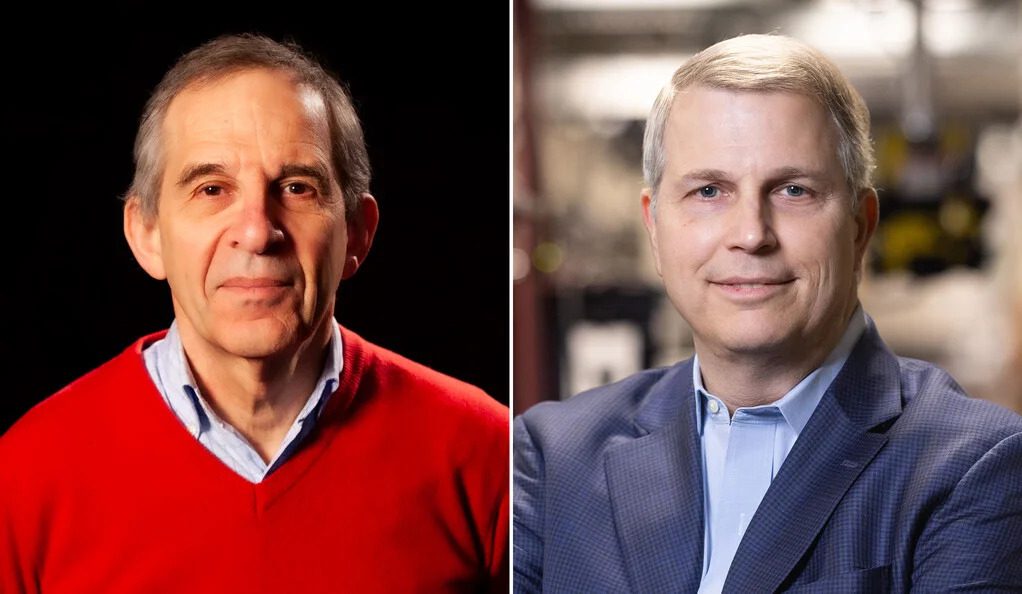Yale scientists win 2024 Comstock Prize in Physics
Professors Michel Devoret and Rob Schoelkopf were awarded the 2024 Comstock Prize in Physics by the National Academy of Sciences for their work on non-linear quantum optics in electrical circuits at the single-photon level.

Yale News
Last month, two Yale researchers won the 2024 Comstock Prize in Physics, a highly prestigious award administered by the National Academy of Sciences every five years for research in electricity, magnetism or radiant energy.
Michel Devoret, a professor of applied physics and Rob Schoelkopf, Sterling Professor of applied physics, were awarded the 2024 prize for their work on non-linear quantum optics — a scientific branch that describes how light moves in irregular media — in electrical circuits at the level of individual photons. Devoret and colleagues discovered quantum behavior in systems larger than atoms, such as circuits, while working as a postdoctoral researcher at the University of California, Berkeley in 1984.
“Our main question was … whether microscopic variables such as current and voltage could be quantum mechanical,” Devoret said in an interview with the News.
During Devoret’s sabbatical year at Yale in 1999, Devoret, Schoelkopf and Steven Girvin, a professor of Physics, began working with quantum behavior in electrical circuits, specifically the fabrication of “artificial atoms” — electronic systems with a discrete number of electrons and energy levels — that are circuits that display atom-like behavior.
After Devoret became a faculty member at Yale in 2002, he and Schoelkopf’s research groups continued to work together. Their collaborations helped create the field of circuit quantum electrodynamics, or circuit QED. Researchers in this field study the behavior and properties of artificial atoms, which are also called quantum circuits due to their quantum mechanical behavior at the circuit scale.
“In a [natural] atom, your nonlinearities are fixed by the universe, but you can engineer these nonlinearities when you have a circuit,” Gautham Umasankar GRD ’28, a second-year doctoral student, who works in Schoelkopf’s lab, told the News.
Circuit QED explains the quantum mechanical behavior at the circuit scale. Devoret and Schoelkopf applied the principles of circuit QED to circuits made out of superconducting materials. During this collaboration, they created the transmon and the fluxonium qubits — two commonly used configurations of superconducting qubits, a type of quantum computing platform that is a promising candidate for the realization of quantum computers.
Since their discovery, superconducting qubits have become increasingly efficient by orders of magnitude. Today, large technology companies, including IBM, Google and Amazon, use superconducting qubits in their attempts to build quantum computers. Many scientists at IBM and Google have also previously worked in Devoret and Schoelkopf’s research teams.
John Garmon GRD ’26 is a fourth-year doctoral student who works in Schoelkopf’s lab. For him, Schoelkopf and Devoret’s collaboration is essential for their research. “The two groups are separate enough to develop initial ideas and projects on their own but also have many collaboration opportunities,” Garmon said.
Charlotte Bøttcher, a postdoctoral researcher in Devoret’s group, previously studied and researched condensed matter physics, a subfield of physics in which researchers study the properties of materials and the origins of quantum phases. In an interview with the News, Bøttcher described how she used circuit QED principles in her graduate studies, informing her current research with Devoret.
“I am currently researching how to utilize new kinds of materials and develop them for innovative circuit QED systems. This collaborative approach between different fields in physics enables advancements in both directions,” Bøttcher told the News.
The Comstock Prize in Physics was first awarded in 1913.







